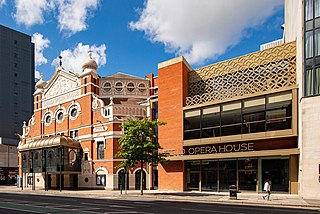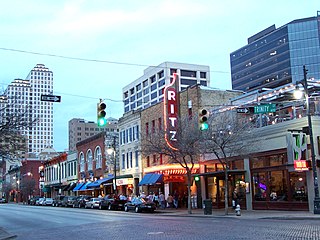History
The Ritz was opened in 1937 under the ownership of Gerald Segelman and designed by Scottish architect Leslie C Norton. Seating was over two levels with 1,240 seats in the stalls and 510 in the circle, giving a total capacity of 1,750.
The building was designed primarily as a cinema and its first offering on 22 February 1937 was San Francisco, starring Clark Gable and Jeanette MacDonald. In 1942 the building suffered minor damage due to German bombing.
In 1954 The Ritz became the first cinema in Lincoln to have CinemaScope installed. Two years later, in January 1956, the building was bought by The Rank Organisation and, as result was renamed The Lincoln Odeon. In 1981, The Rank Organisation decided to close the cinema and it stood empty for the next 3 years.
The building regained its original name when it was acquired in 1984 by Lincoln resident Barry Stead. Stead was keen to introduce live performances to the venue as an additional income at a time when cinema audiences were dwindling. However, at the time the building was not suitable for live performance; the stage was only 12 feet deep, there was no fly system, minimal backstage area and no get-in access, meaning that all set and equipment would need to be able to fit through normal-sized doors. Stead set about making improvements which included the construction of a fore-stage which increased the total depth of the stage to 28 feet. As part of these renovations, 5 dressing rooms were also added to the improved backstage area. These changes paid off and for the next ten years the venue hosted artists such as Sister Sledge, Howard Keel, and Danny La Rue.
By 1994, however, it was becoming apparent that the large auditorium was no longer cost-effective. Multiplex cinemas were by this stage becoming far more common and they provided choice and flexibility that traditional single-screen cinemas could not compete with. As a result, the cinema closed temporarily to allow the conversion of the existing auditorium into a multi-screen venue. In March 1995 the building reopened as the Ritz Film Centre, featuring three screens. The stalls were now cut in half with each screen accommodating 300 patrons whilst the former circle was closed off and used to create a single screen with a larger capacity of 485.
The gamble didn't pay off and although the cinema was now able to offer their audiences a more modern cinema experience the opening of the purpose-built Warner Cinema with its nine screens made the Ritz all but obsolete. The Ritz closed once again in January 1998 and later that year the building was acquired by JD Wetherspoon. The pub chain set about converting the premises for their purposes, using the foyer and stalls but leaving the former circle derelict.
It wasn't until 2013 that the Ritz regained its cinema status. JD Wetherspoon agreed to lease the now disused circle for it to be re-fitted for cinema use again. Pete Genders was to be the Chief Executive and oversaw the renovation. The new 480 seat venue was to become an art-house cinema and community hub but closed unexpectedly in 2017 after the lease had expired.
The Ritz is included on the Local List of Buildings of Architectural Significance and is defined as a landmark corner building within Conservation Area Number 6.

The Odeon Luxe West End is a two-screen cinema on the south side of Leicester Square, London. It has historically been used for smaller film premieres and hosting the annual BFI London Film Festival. The site is on an adjacent side of the square to the much larger flagship Odeon Luxe Leicester Square.

The Rex is a cinema in the town of Berkhamsted, Hertfordshire, England. Designed in the art deco style by David Evelyn Nye in 1936, the cinema opened to the public in 1938. After 50 years of service, the cinema closed in 1988 and became derelict. The building was listed Grade II by English Heritage, and following a campaign to save the Rex by a local entrepreneur, the cinema re-opened to the public in 2004.

The Capitol is an historic theatre on Swanston Street in the central business district (CBD) of Melbourne, Victoria, Australia. Opened in 1924 as part of the Capitol House building, the art deco theatre was designed by American husband and wife architects Walter Burley and Marion Mahony Griffin, and is the oldest of Melbourne's large picture palaces. It is famous for its extravagant decor and abstract motifs, including an intricate geometric ceiling containing thousands of coloured lamps, designed to evoke the walls of a crystalline cave.

Mayflower Theatre is a Grade II listed theatre in the city centre of Southampton, England, with a capacity of 2,300. It features West End theatre shows when they tour the United Kingdom. In addition to this, one-off comedy shows and music events often take place at the theatre too.

The Grand Opera House is a theatre in Belfast, Northern Ireland, designed by the most prolific theatre architect of the period, Frank Matcham. It opened on 23 December 1895. According to the Theatres Trust, the "magnificent auditorium is probably the best surviving example in the United Kingdom of the oriental style applied to theatre architecture". The auditorium was restored to its former glory, and the foyer spaces and bars were reimagined and developed as part of a £12.2 million project in 2020/2021, generously supported by the National Lottery Heritage Fund. [1]

The Victoria Theatre is a heritage-listed former theatre at 8-10 Perkins Street, Newcastle, City of Newcastle, New South Wales, Australia. It was opened in 1876 and rebuilt during 1890-91, and is the oldest theatre still standing in New South Wales. It was added to the New South Wales State Heritage Register on 27 August 1999.

The Erith Playhouse is a theatre in Erith, London.

The Ritz is a historic theater in the 6th Street district in Austin, Texas. The building's history includes use as a movie theater, music hall, club, and comedy house. It reopened after renovations in fall 2007 as the new downtown location for the Alamo Drafthouse. The venue temporarily closed in 2020 due to the COVID-19 pandemic, and was permanently closed in 2021 when the Alamo Drafthouse filed for bankruptcy.
The Whiteladies Picture House is a cinema on Whiteladies Road in Clifton, Bristol, England.

The Tyne Theatre and Opera House is a theatre in Newcastle upon Tyne, England. It is a Grade I listed building[1], rated "in the top 4% of listed buildings" by English Heritage and is afforded a three star rating by the Theatres Trust, "a very fine theatre of the highest theatrical and architectural quality". It opened in 1867 as the Tyne Theatre and Opera House, designed by the Newcastle upon Tyne architecture practice of William Parnell. The backstage area was damaged by fire in 1985, with subsequent rebuilding restoring the Victorian stage machinery.

The Ashcroft Theatre is a theatre located within the Fairfield Halls, Croydon, South London. The theatre was named after Croydon-born Dame Peggy Ashcroft and is a proscenium theatre with a stepped auditorium. The mural on its fire curtain is by the artist Henry Bird. A variety of productions are held throughout the year such as drama, ballet, opera and pantomime. The venue has a seating capacity of 763 and can be converted into a cinema as it has a large screen giving full Cinemascope and standard film format.
Green's Playhouse was an entertainment complex comprising a cinema, ballroom, tea rooms and other facilities. The Playhouse was at 126 Renfield Street, Glasgow, Scotland, commissioned by George Green Ltd, designed by the architect John Fairweather, and built by the Cinema Building Company. Opened in 1927, the Playhouse operated until the 1970s, a decline in audience numbers in the 1960s necessitated diversification as a music venue until closure in 1973. The building continued in use as the Apollo, after being acquired by Unicorn Leisure on a lease-holding arrangement, until final closure in 1985, with subsequent demolition in 1987.

The State Cinema is a Grade II* Listed building in Grays, Essex. Designed by F. G. M. Chancellor under Matcham & Co., it opened in 1938 as one of the most modern cinemas of its type at the time with seating for 2200 people. As a cinema, it closed in 1988 but has held numerous events and been used for various purposes since. Historic England describe the cinema as being "one of the best preserved of the super cinemas of the late 1930s."
In its days as an entertainment centre for London, Harringay in North London also provided more locally directed entertainment in the shape of four cinemas. The earliest was opened in 1910 and was operating as a cinema until January 2003.

The Marina is a theatre and cinema in Lowestoft, Suffolk, originally opened in the Victorian era. The venue has an auditorium seating 800. It plays host to major West End productions, top comedy, orchestral concerts, touring drama and musical productions, opera, ballet, music, dance and celebrity concerts as well as operating a successful cinema operation - boasting the largest screen and cinema auditoria in the town. The Marina annually hosts the largest professional pantomime on the East Anglian Coast.

The New Theatre Royal is a Victorian Grade II* listed theatre in the heart of Portsmouth, England, with a capacity of 667. The theatre building was constructed in 1854 as Landport Hall. It was converted to a theatre two years later. It was rebuilt in 1884 by Charles J. Phipps and again in 1900 by Frank Matcham.

The Deco is a restored 1930s cinema and theatre located in the heart of Northampton, England. It is now operated as a venue for corporate, social and theatrical events.

The Golden Beam is a pub and Grade II listed building located in the Headingley area of Leeds, West Yorkshire, England. It was built in c. 1912 for the Church of Christ, Scientist, and was known as the Elinor Lupton Centre from 1986 to 2010 when it was a school arts centre. It was designed by Piet de Jong and William Peel Schofield from the architectural firm Schofield and Berry. Constructed in white Portland stone in a mixed style of Egyptian Revival and Art Deco, it was originally built as a Sunday school in c. 1912–1914, extended in the 1930s with a church building and then used by the Leeds Girls' High School as a theatre and music centre from 1986 until 2010. The structure has architectural significance in the locality due to its distinct style and use of materials; many original features and fittings survive, including the entrance foyer, two staircases and a glazed lantern in the auditorium roof.
The Prince of Wales Theatre was a theatre on Macquarie Street, Hobart, Tasmania from 1910 to 1987.
The Blair Theatre is a venue located in North Central Kansas in the city of Belleville, Kansas in Republic County.
















